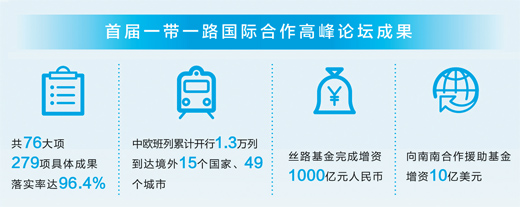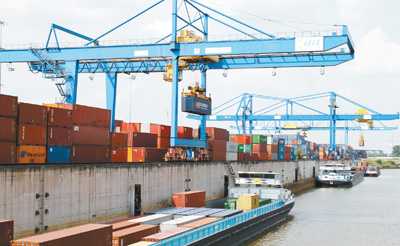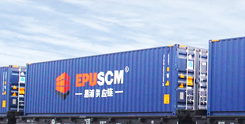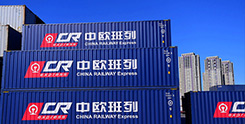Along the way, "a pioneering initiative in twenty-first Century".
Publishdate:2019-03-20 Views:2971


In 2013, President Xi Jinping proposed to build a "one belt and one road" initiative. In 2017, China held the "one belt and one way" International Cooperation Summit Forum. Over the past few years, with the joint efforts of all parties, the "one belt and one road" construction has transformed from vision into action, and from vision to reality, and achieved fruitful results.
In April 2019, China will host the second "one belt and one way" International Cooperation Summit Forum. From today on, this newspaper has launched a series of "wind from the East - International Cooperation on the road and the road" series, which tells the vivid story of "one belt and one road" construction, and shares the profound understanding of the international community's "one belt and one road" initiative. This edition has captured the brilliant idea of the "one belt and one road" initiative of famous people in developed countries since the first International Cooperation Summit Forum on "one belt and one road" was picked up.
"Will be one of the greatest stories of the 21st century"
Robert Lawrence Kuhn, President of the Kuhn Foundation, USA:
In the long history, people of different countries, nationalities, religious beliefs and cultural backgrounds along the Silk Road have created successful precedents for peace and sharing among themselves. Today, the "one belt and one road" initiative proposed by President Xi Jinping also focuses on the common interests of all countries along the line.
China has repeatedly stated that no matter what step it takes to develop itself, it will not bully the small ones in dealing with external relations. The construction of "one belt and one road" is based on solidarity, cooperation, sharing development, equality and mutual benefit. The "one belt and one way" is so popular all over the world because China has found the meeting point of its own development experience with the needs of the world.
100 years later, when the history of our generation has been written down, people will look back and see that today's discussion on "one belt and one road" will be much more important than any election. The construction of "one belt and one road" will become one of the greatest stories of twenty-first Century.
Stephen Perry, chairman of 48 Group clubs in Britain:
The "one belt and one way" initiative is a resuspension of the silk road. It has brought an astonishing and creative modern trade form to the world. Relying on the concept of "one belt and one road" which transcends national boundaries, Asia, Europe, Africa, American countries and people are in harmony. The cornerstone of the "one belt and one road initiative" is to respect the culture and system of every country and nation and to unite people firmly with the goal of achieving sustainable development.
The "one belt and one way" initiative was a transformative project in twenty-first Century. President Xi Jinping gave us a road map, which pointed out the future direction for us. Although the road ahead will be bumpy, we are heading in the right direction. The more we can firmly grasp the opportunities brought by the "one belt and one road initiative", the more we can enjoy the development dividends brought by the initiative.
American futurists Doris Nesbitt and John Nesbitt:
The world needs bridges and wisdom to build them. The "one belt and one road" initiative proposed by President Xi Jinping is an initiative with the meaning of "erecting a bridge". Its broad goal is to narrow the economic gap between developed economies and developing countries and emerging economies, and to promote understanding and exchange across cultural and historical differences.
"One belt and one road" is not only an economic development initiative, but also encourages mankind to solve the global problems facing the future world in a common way.
"One belt and one road" involves a new ideological consensus around economic development, and a higher level of consensus evolution. It also means mutual interference and non alignment. It seeks for the exchange of development experience rather than a development model imposed on another development model. The biggest difference is that it benefits all countries and peoples, not just a small number of people. African countries have benefited from China's support for infrastructure development, which is more effective than copying Western democratic institutions.
Former Prime Minister of New Zealand, Jenny Hippley:
The "one belt and one way" initiative is one of the biggest innovations in promoting international cooperation worldwide. It is a forward-looking concept that may create the next wave of world economic growth.
China has done very well in promoting mutual respect, equality and fairness between countries. In the process of international development assistance, China emphasizes sharing rather than relief, highlights common prosperity and shares the achievements of progress. In fact, international development assistance should not only focus on solving the survival problems of the people of the target countries, but also exert the leverage effect of investment, empower the local people and enable them to achieve independent development in the near future. The "one belt and one road" helps to build up a cross regional and cross national market by helping the countries along the border to upgrade their infrastructure and interoperability.
Former Japanese Prime Minister Yukio Hatoyama:
The "one belt and one way" principle based on the principle of co - operation, co - construction and sharing is an important way to build a community of human destiny. It is a great idea to promote peace and development in the region through the construction of "one belt and one road". Its more profound focus is to promote regional economic development, enhance exchanges between countries, and then prevent disputes, so as to promote peace through development and ensure development peacefully.
"In the long run, it will be a lubricant for global economic growth"
Johnson Watson, President of McKinsey Global Research Institute, USA:
As the Oriental Express in the late nineteenth Century symbolized the second industrial revolution, the "one belt and one road" embodies the trend of economic exchange and cultural integration under the new revolution. "New Oriental Express" will be loaded with the dreams of people's policy communication, facility communication, trade smoothness, capital financing and people's hearts and minds along the line, and will enter the territory of China which is closely linked with other countries and shares opportunities.
Martin Jacques, Senior Fellow, School of Political and International Relations, Cambridge University, UK:
Swimming in the ocean of the world economy, China has achieved a deep integration with the world, which brings opportunities for economic growth and prosperity in many countries and regions. "One belt and one road" is a powerful example. It is precisely because of the importance of development that China can put forward a great initiative such as "one belt and one road". What it wants to solve is the transformation of the developing countries, which account for 85% of the world's population, the core global problem since 1945. It shows that China is striving to find a new type of international relations that will enable China and other countries to achieve mutual benefit and win-win results.
Western countries tend to equate globalization with westernization, thus excluding many countries. But China's understanding of globalization has nothing to do with ideology, economic structure and race. In China's view, globalization means development, which means that the people of all parts of the world will be happier with the help of cooperative initiatives such as "one belt and one road". This non exclusiveness and universality of benefits fully demonstrate the shared spirit advocated by the "one belt and one road".
Reform and opening up is a way of thinking, a process, a transformation method that combines realistic and strategic perspectives. The "one belt and one way" initiative shows the thinking of reform and opening up: in the process of expanding cooperation, we find a more effective and pragmatic approach.
Bob Carr, former Foreign Minister of Australia and Dean of Australia-China Relations at Sydney University of Science and Technology:
If 40 years ago some people predicted that China would one day "export" to the world in infrastructure construction capacity, such as roads, bridges, ports, airports, tunnels, the world would surely feel this is fantastic. However, we see that China is doing these things in earnest today. "One belt and one road" brings China's growth and prosperity to all parts of the world to help Asia and other parts of the world develop together.
Peter Frank Pan, Senior Fellow at Worcester College, Oxford University, UK:
Historically, natural barriers such as mountains, seas and deserts have separated each other, blocked the exchange of ideas and information, and hindered economic, political and cultural development. The "one belt and one road" initiative put forward by China includes the construction of important infrastructures such as highways, railways and ports. Efforts to overcome these physical obstacles are the lessons of historical experience. The "one belt and one way" linking the world and facing the future will be a lubricant for promoting global economic growth for a long time.
"Don't let one person fall behind on the road of development"
Former French Prime Minister De Villepin:
In a world lacking collective action and weakened by the international financial crisis in 2008, President Xi Jinping's "one belt and one road" initiative has a long-term perspective from the beginning. The initiative shows three complementary prospects: politically, promoting tolerance and cooperation between different countries and peoples; economically, promoting economic and trade exchanges, expanding investment to meet the specific needs of development; and culturally, continuing the spirit of the ancient Silk Road and promoting mutual civilized learning among peoples of all countries. To sum up, the "one belt and one way" is a pioneering initiative in twenty-first Century. It is a bridge connecting the past and the present, and leads to the future. It aims at "let no one fall behind" on the road of development.
Over the past few decades, China has become more and more powerful, and its approach to the center of the world stage is probably the most remarkable feature of the world today. It can be said that not only has China ushered in a new era, but it has also ushered in a new global era.
Globalization is at a crossroads. Populism is rising and tearing the world apart. The global economic recovery is overshadowed by protectionism. Many countries are facing instability. China is speeding up the pace of opening up, believing that "one belt and one road" will bring together the fragmented world and bring new opportunities for the development and common stability of all countries.
Mark Uzan, Executive Director of the French Commission for the Reconstruction of the Bretton Woods System:
The development of "one belt and one road" to enhance interconnection will lead to the development of countries and regions along the route and create a more inclusive and sustainable global development model. "One belt and one road" also provides China's plan for the problems that globalization may face. With economic growth and continuous improvement of people's lives, those voices against the trend of the times will inevitably be destroyed.
At present, there is a voice of "anti-globalization" in the world, and the functions of some international cooperation mechanisms seem to be weakening. China has put forward the initiative of "one belt and one road" and initiated the establishment of the Asia Investment Bank, which has provided a new path for promoting the opening, tolerance and sustainable development of the world economy, so that many "marginalized" countries have the opportunity to participate in international cooperation and share the dividends of economic globalization, which will surely compose a new chapter of globalization.
Hiroki Okumura, Senior Fellow of Japan's Science and Technology Revitalization Agency:
Today's dramatic changes in China are closely related to policy coherence and implementation. President Xi Jinping's "one belt and one road" initiative and the idea of building a community of human destiny show China's firm determination to continue its reform and opening up, and China is willing to share the successful experience and opportunities of reform and opening up with the rest of the world, so as to contribute to world peace and common development.
The "one belt and one way" initiative has brought China's opening to the outside world to a new level. It links China's development with that of Asia, Europe and even the whole world, thus forming a dynamic and sustainable development path. Many Japanese people of insight want Japan to join the "one belt and one way". If Japan just watches, it will lose many opportunities for development.
Kim Kenmin, Chief Research Fellow, Fujitsu Institute of General Research and Economics, Japan:
In recent years, owing to the problems of weak world economic growth, widening gap between the rich and the poor in China and the continuing refugee crisis, the anti-globalization trend of thought in some developed economies has surged, and the temptation of "giving priority to national interests" has begun to spread. Developing countries expect trade and investment liberalization to drive economic development and create employment. The contradiction between developed and developing economies is intensifying. It is urgent to put forward and try a new framework model of global economic governance.
The "one belt and one way" initiative is not only the innovation of the concept of "new globalization", but also provides a common framework and stage for developing economies and developing economies to increase their employment and eliminate poverty. China has also pooled global resources, arranged and implemented the funds, technologies and talents needed for the initiative, bringing "real gold and silver" to the initiative.
Harvey Chaoting, Legal Adviser to the Carter Administration of the United States:
Building bridges of connections can lead to prosperity, while building walls of isolation can only lead to dead ends of development. The construction of "one belt and one road" is an example of China's efforts to promote economic globalization and multilateralism.
"Century Project Including Innovative Ideas in the Age of Globalization"
Michel Aleta, French economist and founder of the School of Regulation:
President Xi Jinping has long-term goals and strategic vision. His proposed "one belt and one road" initiative is ingenious in design and accurate in positioning, allowing funds, talents and technology to flow to ensure that the relevant countries are mutually beneficial and win in the tide of world economic development. With the help of the "one belt and one way" construction, many countries have developed their economies, tended to be stable, and managed better.
In the context of deepening reform and opening wider to the outside world, China's "one belt and one road" initiative has accelerated the cross-border movement of capital. This model is totally different from the short-sighted financial control model dominated by Wall Street for more than 40 years. It seeks a variety of forms of interdependence: interconnection, mutual trade and long-term investment. The construction of "one belt and one road" will help solve global governance problems such as unbalanced development and resource deterioration.
He Zewei, Israeli Ambassador to China:
"Along the way" always reminds me of a love song, one of which is "where do we start?" Israel has a traditional friendly and cooperative relationship with China. Chinese companies have carried out some large-scale infrastructure projects in Israel, from which the Israeli people have benefited a lot. Under the framework of "one belt and one road", the most advantageous cooperation between China and the two countries is innovative cooperation. There is a huge potential for innovation cooperation between the two countries. Israeli high-tech companies will cooperate with Chinese companies in various fields.
Leonidas Rokanas, Greek Ambassador to China:
The "one belt and one way" initiative provides a pioneering thinking for solving global challenges. Under the framework of "one belt and one road", cultural cooperation and mutual understanding among people from different countries and regions have been enhanced, which is of great benefit to the future development.
"One belt and one road" advocates open cooperation, does not engage in protectionism, truly promotes trade and investment, promotes interconnection, and promotes growth and development. This is of great significance to Greece, the poor economic growth in Europe and the future of economic globalization, which are deeply affected by the financial crisis.
Japan Institute of International Trade and Investment Chief Economist Jiang Yuanyuan:
In the history of mankind, no one has ever advocated the goal of "win-win cooperation", like "one belt and one road". More than 140 countries and regions and more than 80 international organizations have actively supported and participated in the construction of "one belt and one road", which effectively proves that the "one belt and one road" has won worldwide resonance.
In the process of "one belt and one road" construction, the whole world saw China's pursuit of fair and reasonable globalization and China's unswerving attitude towards building a community of human destiny. "One belt and one road" is a century old project that contains innovative ideas in the era of globalization.
"The Way to Connect Human Knowledge and Wisdom"
Former French Prime Minister Raffan:
China has promoted multilateral cooperation by proposing the "one belt and one way" initiative. It has set an example for the international community. China's long-term goals and grasp of the needs of the times are of great benefit to the development of the world. In a world marked by innovation, I think China has a great trump card, that is, the Chinese civilization with a long history and profound. "One belt and one road" is a great plan that needs innovation, needs construction and needs to be shared. China's voice in the world is the voice of balance, multilateral cooperation and, naturally, progress.
Some western countries have doubts about the "one belt and one road". That's because China has not duplicated the Western model, but has created its own way of development, a more inclusive way of development.
It seems that embroidery on silk requires a thread-by-thread effort. The construction of "one belt and one road" is also the case. We need to rely on step by step to get results. The construction of "one belt and one road" needs the joint planning and careful layout of all countries.
British Business Ambassador Barbara Jiaqi:
We urgently need to further enhance the understanding of China in the outside world, especially in the Western countries. However, some western media reports on China have not fully conveyed the information of development, and there are still obstacles and gaps in communication. It is suggested that the global media should take a far sighted view not only to pay more attention to China, but also to other countries participating in the "one belt and one way" construction. We should actively disseminate opportunities for the "one belt and one way" construction and promote effective communication between the countries along the line, thereby enhancing our understanding of China and the "one belt and one road" construction.
Jacques Goldfland, President of the Charles de Gaulle Foundation, France:
Since the "one belt and one road" initiative was put forward, the countries along the line have carried out positive and fruitful cooperation. In view of the current trend of counter globalization, the construction of "one belt and one road" can prove to those skeptics that the process of globalization can be organized and regularly carried out among countries. It is not only a mutually needed trade path, but also a development road linking human knowledge and wisdom, which will truly benefit the people of all countries.
Herman, CEO of Siemens in Greater China, Germany:
The international community is optimistic and confident that China's economy will achieve high-quality growth. In my view, this optimism and confidence come largely from China's "belt and road initiative" and a series of macroeconomic policies and measures. "Along the way" is not only the "hot word" of this era, but also a vivid fact that happens. It is the most important and influential global infrastructure construction plan nowadays, which provides more powerful impetus to globalization and has great potential to build a blueprint for new global trade.
Leibniz, a famous German philosopher, holds that cultural exchanges between Europe and China are not only about learning each other's historical knowledge and achievements of civilization, but also can spark new creative ideas in cultural exchanges and collisions, thus promoting the development of the two civilizations.
Today, when digitalization pushes the value across national boundaries at an unprecedented speed, when the "one belt and one road" promotes common prosperity in an unprecedented spirit of cooperation, when economic globalization sweeps through every corner with unprecedented force, no geographical, cultural, ethnic, political or ideological differences should be our obstacle.









